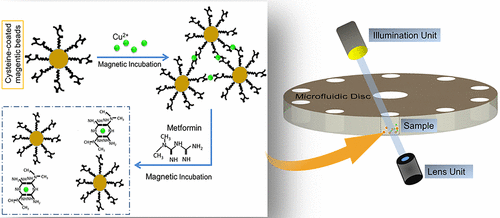Our official English website, www.x-mol.net, welcomes your feedback! (Note: you will need to create a separate account there.)
New Evidence for the Mechanism of Action of a Type-2 Diabetes Drug Using a Magnetic Bead-Based Automated Biosensing Platform
ACS Sensors ( IF 8.9 ) Pub Date : 2017-08-18 00:00:00 , DOI: 10.1021/acssensors.7b00384 Rokon Uddin,null Nur-E-Habiba,Graham Rena,En-Te Hwu,Anja Boisen
ACS Sensors ( IF 8.9 ) Pub Date : 2017-08-18 00:00:00 , DOI: 10.1021/acssensors.7b00384 Rokon Uddin,null Nur-E-Habiba,Graham Rena,En-Te Hwu,Anja Boisen

|
The mechanism of action (MOA) of the first line type-2 diabetes drug metformin remains unclear despite its widespread usage. However, recent evidence suggests that the mitochondrial copper (Cu)-binding action of metformin may contribute toward the drug’s MOA. Here, we present a novel biosensing platform for investigating the MOA of metformin using a magnetic microbead-based agglutination assay which has allowed us to demonstrate for the first time the interaction between Cu and metformin at clinically relevant low micromolar concentrations of the drug, thus suggesting a potential pathway of metformin’s blood-glucose lowering action. In this assay, cysteine-functionalized magnetic beadswere agglutinated in the presence of Cu due to cysteine’s Cu-chelation property. Addition of clinically relevant doses of metformin resulted in disaggregation of Cu-bridged bead-clusters, whereas the effect of adding a closely related but blood-glucose neutral drug propanediimidamide (PDI) showed completely different responses to the clusters. The entire assay was integrated in an automated microfluidics platform with an advanced optical imaging unit by which we investigated these aggregation–disaggregation phenomena in a reliable, automated, and user-friendly fashion with total assay time of 17 min requiring a sample (metformin/PDI) volume of 30 μL. The marked difference of Cu-binding action between the blood-glucose lowering drug metformin and its inactive analogue PDI thus suggests that metformin’s distinctive Cu-binding properties may be required for its effect on glucose homeostasis. The novel automated platform demonstrating this novel investigation thus holds the potential to be utilized for investigating significant and sensitive molecular interactions via magnetic bead-based agglutination assay.
中文翻译:

使用基于磁珠的自动化生物传感平台的2型糖尿病药物作用机理的新证据
尽管广泛使用,但一线2型糖尿病药物二甲双胍的作用机理(MOA)仍不清楚。但是,最近的证据表明,二甲双胍的线粒体铜(Cu)结合作用可能有助于该药物的MOA。在这里,我们介绍了一种新颖的生物传感平台,用于使用基于磁微珠的凝集测定法研究二甲双胍的MOA,这使我们首次证明了在临床上相关的低微摩尔浓度药物中Cu与二甲双胍之间的相互作用,从而表明二甲双胍降血糖作用的潜在途径。在该测定中,由于半胱氨酸的铜螯合特性,在存在铜的情况下将半胱氨酸官能化的磁珠凝集。加入临床相关剂量的二甲双胍可导致铜桥珠簇解聚,而添加密切相关但血糖中性药物丙二酰胺(PDI)的效果则显示出对簇的完全不同的反应。整个测定都集成在带有先进光学成像单元的自动化微流控平台中,通过该平台我们以可靠,自动化和用户友好的方式研究了这些聚集-聚集现象,总测定时间为17分钟,需要样品(二甲双胍/ PDI) )30μL的体积。降低血糖的药物二甲双胍与其非活性类似物PDI之间的Cu结合作用明显不同,因此表明二甲双胍具有独特的Cu结合特性可能需要其对葡萄糖稳态的影响。
更新日期:2017-08-18
中文翻译:

使用基于磁珠的自动化生物传感平台的2型糖尿病药物作用机理的新证据
尽管广泛使用,但一线2型糖尿病药物二甲双胍的作用机理(MOA)仍不清楚。但是,最近的证据表明,二甲双胍的线粒体铜(Cu)结合作用可能有助于该药物的MOA。在这里,我们介绍了一种新颖的生物传感平台,用于使用基于磁微珠的凝集测定法研究二甲双胍的MOA,这使我们首次证明了在临床上相关的低微摩尔浓度药物中Cu与二甲双胍之间的相互作用,从而表明二甲双胍降血糖作用的潜在途径。在该测定中,由于半胱氨酸的铜螯合特性,在存在铜的情况下将半胱氨酸官能化的磁珠凝集。加入临床相关剂量的二甲双胍可导致铜桥珠簇解聚,而添加密切相关但血糖中性药物丙二酰胺(PDI)的效果则显示出对簇的完全不同的反应。整个测定都集成在带有先进光学成像单元的自动化微流控平台中,通过该平台我们以可靠,自动化和用户友好的方式研究了这些聚集-聚集现象,总测定时间为17分钟,需要样品(二甲双胍/ PDI) )30μL的体积。降低血糖的药物二甲双胍与其非活性类似物PDI之间的Cu结合作用明显不同,因此表明二甲双胍具有独特的Cu结合特性可能需要其对葡萄糖稳态的影响。



























 京公网安备 11010802027423号
京公网安备 11010802027423号